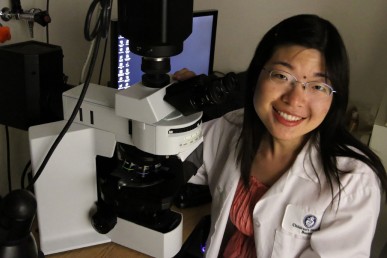Body’s own defenses might stop ALS onset
It may be possible to enlist the body’s own repair tools to fix toxic misshapen protein molecules implicated in neurodegenerative diseases such as ALS, researchers report in the Proceedings of the National Academy of Sciences.
A team of researchers from the University of Illinois at Chicago, Harvard University and Yale University was able to show for the first time that cellular molecules called chaperones, which guide protein molecules to fold into their proper working shapes, can prevent the toxic effects of misfolded proteins in neurons.
“One of the questions that has long been raised is why the cell’s chaperones, which can refold these misfolded proteins, don’t prevent these diseases?” says Scott Brady, professor and head of anatomy and cell biology at the UIC College of Medicine, and principal investigator on the study.
Brady and former graduate student Yuyu Song, now a postdoctoral researcher at Boston Children’s Hospital and Harvard Medical School, both focus on the mechanism of nerve fiber conduction. They teamed up with Arthur Horwich, who heads a leading laboratory in the biology of chaperones at the Howard Hughes Medical Institute at Yale School of Medicine.
They began with a mouse model of ALS in which a mutated form of a human protein called SOD1, linked to human ALS, is produced in the mice’s nerve cells. The protein misfolds and clumps together to produce signs of the disease, says Song, who is first author on the new study.
Using a long nerve fiber taken from a squid, the researchers showed that in three different forms of mutated SOD1, its toxicity comes from activating a series of cellular chemical reactions that cause a drop in axonal transport, the shuttling of proteins along the long fibers of the neuron.
The researchers next wanted to see if an excess of a chaperone called HSC70, already abundant in cells, could blunt the protein molecule’s toxicity. Adding excess HSC70 to the squid axon did partially reverse the axonal transport defect.
“But clearly it wasn’t fixing the problem,” said Brady.
However, adding HSP110, a chaperone with a slightly different function, did completely block activation of the cellular reaction pathway and restore axonal transport.
“I think this the first time a chaperone has been shown to essentially reverse a process like this,” Brady said. “We need to learn much more about the different chaperones and how they combine and cooperate.”
Because HSC70 exists naturally in the squid axon, it’s impossible to know whether the added HSP110 works alone or in cooperation with it, Brady said. The two chaperones are known to cooperate in other settings, and since HSP110 is effective even when added in extremely small amounts, said Song, cooperation seems likely.
Song plans to pursue the question of what makes misfolded SOD1 toxic.
“It’s possible that the misfolding exposes a sticky domain, which interacts with neuronal proteins to produce a toxic combination, (and) the chaperones are able to bind to that domain and sequester it,” she said.
Brady said the study began through a unique collaboration at the Marine Biological Laboratory in Woods Hole, Mass., where Brady runs a lab each summer. His former graduate student Song “realized the potential synergy” between their research and that of Horwich. Song has just begun postdoctoral study with Horwich at Yale in order to continue their collaboration.
Other co-authors are Maria Nagy, Weiming Ni, Navneet Tyagi and Wayne Fenton of the Yale School of Medicine and Francesc Lopez-Giraldez and John Overton of Yale University.

